
Haltadefinizione is a company located in Italy, which specializes in high-resolution reproductions of historical heritage of world-class. As a technology partner, CLAUSS provides the best and latest developments in the field of robotics and automatic image recording for free.
Haltadefinizione® LAB ![]() develops technologies for the ultra-high definition digitisation and the diagnostics of works of art ensuring outstanding results in all image acquisition conditions with a wide range of cultural materials, from small paintings to large frescoed walls, all the way to manuscripts and ancient documents.
develops technologies for the ultra-high definition digitisation and the diagnostics of works of art ensuring outstanding results in all image acquisition conditions with a wide range of cultural materials, from small paintings to large frescoed walls, all the way to manuscripts and ancient documents.
PROJECT : Scrovegni Chapel in Padua ![]() (Nov 2010)
(Nov 2010)
High-resolution reproduction of the frescoes by Giotto di Bondone ![]()
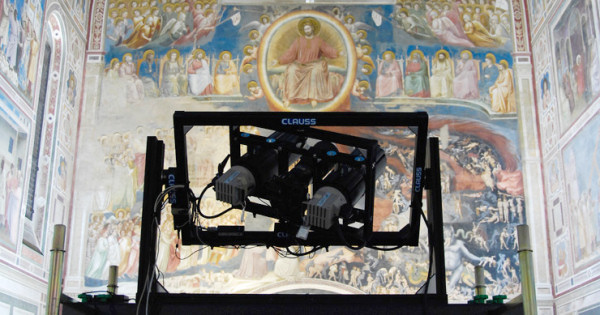
PROJECT : Basilica of San Francesco d' Assisi (2009)
High-resolution reproduction of the frescoes by Giotto di Bondone ![]()
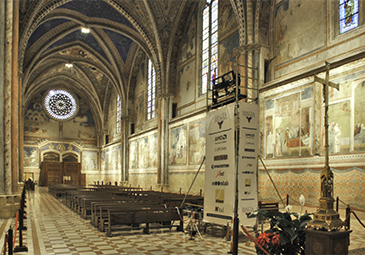 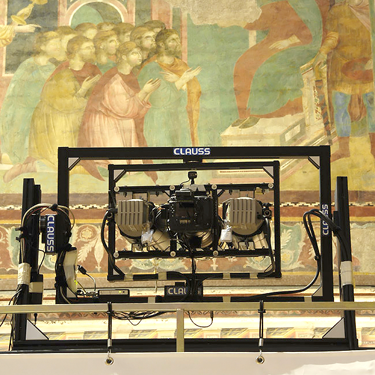 |
The frescoes were scanned with the specially designed Clauss RODEON VR Head GT, which offers the opportunity to move two studio flash lamps (Elinchrom Digital S) with focusing optics (Elinchrom Zoom Spot 18 - 36°) along with the camera (Nikon D3x) with long focal length lenses (Nikon AF-S NIKKOR 600 mm 1:4D IF-ED II). The VR Head possesses a gimballed mount which has been designed with sufficient measure (122 cm x 80 cm), that the whole inner frame including all the photographic equipment is able to rotate through. For gears, the approved models from the Clauss RODEON VR Head HD with 72,000 steps and electromagnetic brake have been used.
This special construction, which allows it to move the light along with the camera, stands out by its proven low light impact on these art treasures.
PROJECT : The Last Supper ![]() (2007)
(2007)
High-resolution reproduction of the frescoe by Leonardo da Vinci
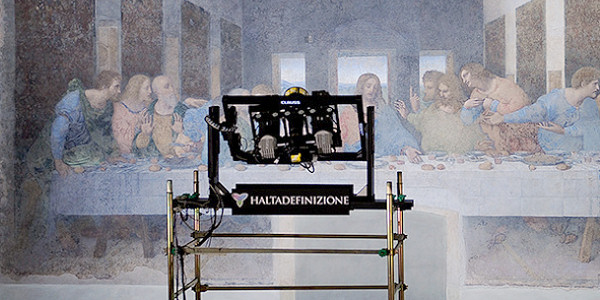
The project started at the beginning of 2007, as a result of the meeting between the Ministry of Cultural Assets and Activities - Milan Landscape and Architectural Assets Office, De Agostini and HAL9000, a worldwide leader in the high-definition photography sector.
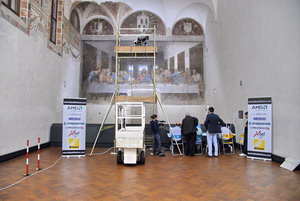 The photograph of "The Last Supper," one of the most delicate and protected works in the world, is the result of many months of work and research, during which specific lighting and photography techniques were developed. The protection of the painting was, right from the start, the main concern of the HAL9000 technicians and the Architectural Assets Office; the photography system was subject to technical inspection at the Environmental Control and Physics Laboratory at the Central Restoration Institute in Rome, which decided the system was totally suitable in accordance with current standards for the safeguarding of artistic works.
The photograph of "The Last Supper," one of the most delicate and protected works in the world, is the result of many months of work and research, during which specific lighting and photography techniques were developed. The protection of the painting was, right from the start, the main concern of the HAL9000 technicians and the Architectural Assets Office; the photography system was subject to technical inspection at the Environmental Control and Physics Laboratory at the Central Restoration Institute in Rome, which decided the system was totally suitable in accordance with current standards for the safeguarding of artistic works.
The project was made possible thanks to the assistance of various partners: AMD, an American multinational which provided the high-tech processing technology; CLAUSS, a German company which provided the high-precision orientation structure, De Agostini, who provided web and communication support; I-Net, who provided high-speed Internet access, and Nikon, for high-tech state-of-the-art photographic equipment.
Clauss RODEON VR Head is the panoramic head that has made it possible to create an innovative, accurate and stable pointing system which allows the camera and the lighting device to work simultaneously.
The Clauss RODEON VR Head is a product which offers enormous flexibility by adapting expertly to any kind of panoramic shot, it allows complete and precise 360° orientation by the camera of the desired object or scene. The Clauss RODEON VR Head provides geometrically correct installation for all camera types, both consumer and professional.
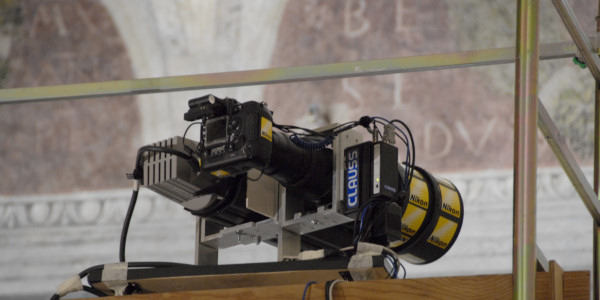
The modularity of the system allows simple, rapid and efficient adaptability to any shooting condition, both indoor and outdoor. The system can be worked by remote control, both wireless or cable, to perform either automated or user interactive operations. Thanks to the continuous support from CLAUSS, this system has allowed for the development of an extremely sophisticated pointing device which was expressly designed for the photographing of "The Last Supper."
One of the main features of the Clauss RODEON VR Head system is the very high pointing resolution, only a 54 second arc, which allows full control of 24,000 different pointing positions on a single rotation of the camera, both horizontally and vertically.
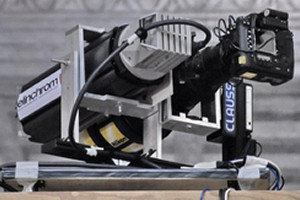
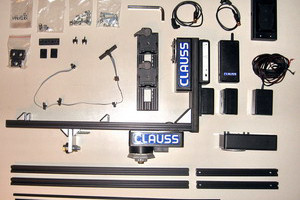
The modularity of the Clauss RODEON Modular system is the key feature which facilitated the designing, in a brief time, of a custom built unit with the mechanical properties required for the shooting of "The Last Supper." The possibility to take advantage of different communication interfaces made it easier to satisfy the system's reliability requirements. Reliability was also increased by the motor units communicating with the main control unit through the dedicated bus system.
The RODEON Modular motor units are not only highly accurate in pointing, but are also very compact despite the considerable power drive which is capable of guaranteeing a 4 Nm torque for a fluid and precise motion even when operating a device weighting 20kg like the one used for the shooting of "The Last Supper."
PROJECT : Sala delle Asse at Sforza Castle (2013)
Ultra-high definition imaging of Leonardo’s ceiling painting in Milan’s Sforza Castle
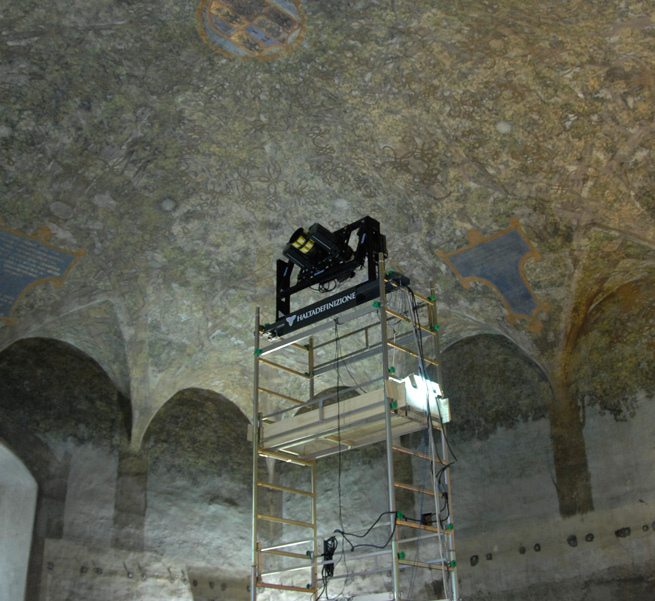
Haltadefinizione’s team has completed the ultra-high definition digital imaging of the vaulted ceiling and walls of the Sala delle Asse, the heart of the Sforza Castle in Milan and a controversial example of Leonardo's work as a court artist to Ludovico Sforza. The imaging campaign was undertaken in view of the restoration that the whole room is to undergo in the following months and which will probably lead to new important discoveries.
The digital imaging process has allowed to capture photographic records of every detail of the frescoes, with over 220 gigapixels of data, and will play a key role in the planning of future conservation activities.